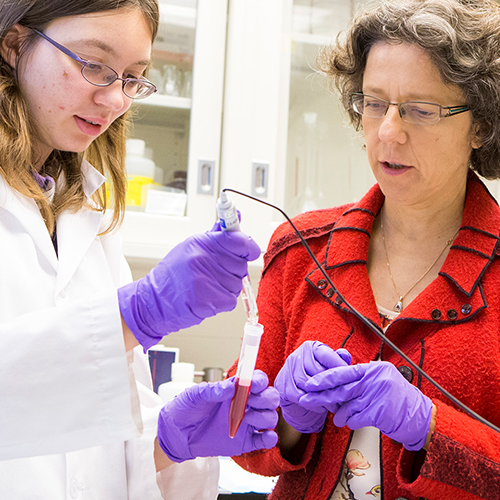CoBRE Phase II Projects
-
The Role of Glucose Homeostasis During Respiratory Infections
Support Period: 2018 - Present
Project Leader: Veronique A. Lacombe, Ph.D., Department of Physiological Sciences, College of Veterinary Medicine, Oklahoma State University
Project Mentors:
Gillian Air, Ph.D., Department Biochemistry and Molecular Biology, College of Medicine, The University of Oklahoma Health Science Center
Clint Jones, Ph.D., Department of Veterinary Pathobiology, College of Veterinary Medicine, Oklahoma State University

Project Summary:
While diabetes, defined by a persistent hyperglycemic state, has reached epidemic levels, respiratory infections (e.g., influenza) have long held a high spot in the list of worldwide causes of death. Importantly, the incidence of hyperglycemia is a major and independent risk factor for the development and worsening severity of pulmonary infection. Although the lung is a major organ to utilize glucose, the role and the regulation of glucose homeostasis in the lung have received little attention. Glucose uptake from the bloodstream, the rate-limiting in glucose utilization, is tightly regulated by a family of specialized proteins, called the glucose transporters (GLUTs). Because every cell expresses these GLUTs, they are recognized as major regulators of whole-body glucose metabolism and thus are key pharmacological targets. However, little is known about the regulation of glucose transport in the respiratory system, particularly during a hyperglycemic state. Therefore, we hypothesize that GLUT activity in the diabetic lung modulates airway surface liquid glucose concentration and viral proliferation. The specific aims of this project are to test the hypotheses that: 1) diabetes will alter GLUT activity in the lung through an Akt/AS160 dependent pathway; 2) rescuing GLUT activity will improve airway surface liquid glucose concentration and thus decrease viral proliferation in the lung and the severity of influenza infection of diabetic animals. We will use a comprehensive, integrated approach at multiple system levels using state-of-the-art techniques. Insights gained from this study could lead to the identification of novel metabolic therapeutic targets for patients affected by diabetes and concurrent respiratory infections, a crucial outcome of this award.
-
ZFC3H1 Regulation of Host Defense and Influenza A Virus Pathogenesis
Support Period: 2018 - 2019
Project Leader: Shitao Li, Ph.D., Department of Microbiology and Immunology, College of Medicine, Tulane University
Project Mentors:
Clint Jones, Ph.D., Department of Veterinary Pathobiology, College of Veterinary Medicine, Oklahoma State University
Lin Liu, Ph.D., Department of Physiological Sciences, College of Veterinary Medicine, Oklahoma State University
Jordan Metcalf, M.D., Department of Medicine, Pulmonary and Critical Care, College of Medicine, The University of Oklahoma Health Sciences Center

Project Summary:
Influenza A virus (IAV) is a highly transmissible respiratory pathogen and presents a continued threat to global health, with considerable economic and social impact. IAV comprises a plethora of strains with different virulence determinants that contribute to influenza pathogenesis. Several determinants in non-structural protein 1 (NS1) of high pathogenic IAV strains have been found to subvert host defense and increase virulence. However, the NS1 of 2009 pandemic IAV lacks all these virulence determinants. To discover the new virulence determinant, we recently systematically analyzed NS1 protein complexes and found that the host factor, zinc finger C3H1-type containing protein (ZFC3H1) specifically interacted with NS1 of 2009 pandemic IAV. Our pilot experiments revealed that ZFC3H1 facilitates RNA exosome to degrade viral RNA, thereby limiting influenza replication. Based on our preliminary data, we hypothesize that the pandemic flu NS1 possesses a new virulence determinant that inhibits ZFC3H1-mediated RNA degradation and improves viral RNA stability. Aim 1 will identify the new NS1 virulence determinant of pandemic flu and determine its role in IAV pathogenesis. Aim 2 will define how ZFC3H1 restricts IAV replication via destabilizing viral RNA. Aim 3 will determine the mechanisms by which the new NS1 determinant antagonizes ZFC3H1. Overall, this proposal will uncover a new NS1 virulence determinant of 2009 pandemic flu and reveal how the determinant perturbs host RNA decay machinery by engagement with ZFC3H1. The outcomes of our study will not only help develop effective therapeutics, but is also crucial for prediction of future potential epidemics and pandemics. -
Phage-like Chromosomal Islands and Virulence in Pneumococci
Support Period: 2018 - 2019
Project Leader: William Michael McShan, Ph.D., Department of Pharmaceutical Sciences, College of Pharmacy, The University of Oklahoma Health Sciences Center
Project Mentor:Mark Coggeshall, Ph.D., Department of Arthritis & Clinical Immunology, Oklahoma Medical Research Foundation
Robert Welliver, M.D., Department of Pediatrics, College of Medicine, The University of Oklahoma Health Science Center
Rodney Tweten, Ph.D., Department of Microbiology and Immunology, College of Medicine, The University of Health Science Center
Project Summary:
Streptococcus pneumoniae is a major cause of human respiratory disease worldwide. 30% of severe cases are caused by strains that are fully resistant to one or more clinically relevant antibiotics. Previously, the PI has shown that phage-like chromosomal islands (CI) in group A streptococci cause the cell to 1) adopt a mutator phenotype through disruption of DNA mismatch repair, which promotes antibiotic resistance, and 2) alter global transcription, up-regulating virulence genes that can enhance pathogenecity, including biofilm formation and antibiotic resistance. We have constructed strains of S. pneumoniae TIGR4 that differ by the presence or absence of a novel Cl in S. pneumoniae (SpnCI) has been identified that has the potential to inactivate a required gene for nucleotide excision repair. Preliminary studies show that such element alter global transcription patterns, including genes that contribute to survival and/or biofilm formation. The hypothesis of this application is that SpnCI also confers a mutator phenotype and alters global transcriptional patterns that may increase virulence or promote survival. To test this hypothesis, the following specific aims will be performed: 1) analyze impact SpnCI has in the acute immune response in an infection model, and 2) determine the SpnCI-associated impact upon biofilm formation and virulence. The PI is highly qualified to perform these studies, having pioneered the discovery and characterization of these streptococcal Cl. The proposed studies will have a positive impact, fundamental advancing our understanding of the biology of this pathogen and may lead to new antimicrobial strategies and improved patient care. -
Preclinical Assessment of OHet72 as a New Drug in the Armamentarium Agains TB and
MDR-TB
Support Period: 2019-2021
Project Leader: Lucila Garcia-Contreras, Ph.D., Department of Pharmaceutical Sciences, College of Pharmacy, The University of Oklahoma Health Sciences Center
Project Mentors:
Mark Coggeshall, Ph.D., Department of Arthritis & Clinical Immunology, Oklahoma Medical Research Foundation
Eric Nuermberger, M.D., Department of Medicine - Infectious Diseases, Johns Hopkins Univeristy School of Medicine

Project Summary:
global control of tuberculosis (TB) is threatened by an increased number of multi-drug resistant TB (MDR-TB) cases and the low rates of cure achieved with current treatments. Thus, potentially useful new drugs and alternative drug delivery strategies are urgently needed. SHetA2 and OHet72 are novel anticancer drugs that also have significant activity against Mycobacterium tuberculosis, (MTB). As an alternative administration strategy, we have developed inhalable nanocrystal formulations of SHetA2 and OHet72 for delivery to the alveolar region of the lung, the main place of MTB residence. Pharmacokinetic (PK) studies of SHetA2 in mice indicated that the therapeutic dose would be larger than that of other inhalable products. OHet72 appears to be more promising since its MIC is 10-fold smaller than that of SHetA2, and PK studies in mice are ongoing. In the present application, we propose to use the guinea pig model of tuberculosis, considered the gold standard of in vivo models, to extend our preclinical studies. We will (1) Investigate the mechanism by which OHet72 kills MTB and explore possible synergy with existing anti-TB drugs in vitro, (2) Assess the pharmacokinetics of OHet72 in vivo; (3) Determine the safety of repeat pulmonary administrations of OHet72; and (4) Evaluate the efficacy of the inhaled treatment with OHet72 in the TBguinea pig model. The results of this project will be used in an R01 application to develop a platform (drug powder + inhaler) to be used in combination with selected anti-TB drugs.
-
Two Pathways for Calcium Signaling and Virulence Regulation in P. aeruginosa
Support Period: 2018 - Present
Project Leader: Marianna Patrauchan, Ph.D., Department of Microbiology and Molecular Genetics, College of Arts and Sciences, Oklahoma State University
Project Mentor:
Tyrrell Conway, Ph.D., Department of Microbiology and Molecular Genetics, College of Arts and Sciences, Oklahoma State University
Michael Franklin, Ph.D., Department of Microbiology and Immunology, College of Letters and Science, Montana State University
Jordan Metcalf, M.D., Department of Medicine, Pulmonary and Critical Care, College of Medicine, The University of Oklahoma Health Sciences Center

Project Summary:
Pseudomonas aeruginosa is an opportunistic human pathogen that causes severe, life threatening infections in patients with cystic fibrosis (CF), endocarditis, wounds, artificial implants, and in healthcare-associated infections. The versatility of P. aeruginosa pathogenicity is associated with an outstanding physiological adaptability of the organism and its ability to modulate host responses, due in part to a tightly coordinated regulation of gene expression. Therefore, to gain control over currently untreatable Pseudomonas infections, it is critically important to generate new knowledge of the regulatory circuits coordinating the pathogen virulence in response to host factors. Calcium ion (Ca2+) is an essential intracellular messenger in eukaryotic cells, regulating vital cellular processes. It accumulates in pulmonary fluids of CF patients and in mitral annulus of endocarditis patients. Alterations in the host Ca2+ homeostasis may serve as a trigger for enhanced virulence of invading pathogens. In support, we showed that Ca2+ positively regulates biofilm formation, swarming, and production of several virulence factors in P. aeruginosa. However, the molecular mechanisms of such regulation are not known. It is also not known whether intracellular Ca2+ plays role as a second messenger in prokaryotes as it does in eukaryotes. Understanding the mechanisms of Ca2+ regulation, signaling and homeostasis will provide novel means for controlling P. aeruginosa viability, virulence, and interactions with the host. Earlier, we identified two putative Ca2+-binding proteins EfhP and CarP, mutations in which cause multiple Ca2+-dependent defects in virulence and infectivity. EfhP contains two EF-hand motives, known to bind Ca2+ and relay Ca2+ signal through conformational changes. CarP is predicted to form a beta-propeller and has a putative phytase domain. Based on the bioinformatics and preliminary studies, we hypothesize that EfhP and CarP provide different routes of Ca2+ signal transduction regulating virulence and host-pathogen interactions in response to Ca2+ in a host. To test this, we propose to determine the cellular localization and identify binding partners and signal-transducing pathways regulated by the two proteins. We will also characterize the role of EfhP and CarP in P. aeruginosa interactions with a host, and define their involvement in the development of acute and chronic infections. By utilizing the expertise of three OCRID core facilities, we will unravel the mechanisms of Ca2+ signaling and its role in regulating the ability of P. aeruginosa to cause infections at the molecular, cellular, and organismal level. This research is highly innovative as for the first time it will experimentally demonstrate Ca2+ signaling in bacteria, identify the components of Ca2+ signal transduction pathways, and define the role of Ca2+ signaling in P. aeruginosa pathogenicity in vivo. -
Inflammatory monocyte-macrophages in age-related susceptibility to SARS-CoV-2 infection
Support Period: 2021 - Present
Project Leader: Rudra Channappanavar, Ph.D. D.V.M. Department of Veterinary Pathobiology, College of Veterinary Medicine, Oklahoma State University

Project Mentors:
Susan Kovats, Ph.D., Arthritis & Clinical Immunology Research Program, Oklahoma Medical Research Foundation
Lin Liu, Ph.D., Department of Physiological Sciences, College of Veterinary Medicine, Oklahoma State University
Project Summary:
Emerging human coronaviruses (hCoVs) such as SARS-CoV, MERS-CoV, and SARS-CoV-2 pose a significant challenge to global public health. hCoVs successfully evade host immunity, replicate to high titers, causing ‘cytokine storm’, acute lung injury (ALI), acute respiratory distress syndrome (ARDS), and fatal pneumonia. Aged individuals are highly susceptible to SARS, MERS, COVID19, with case fatality rate ranging from 35-80%. However, the specific virus and host factor/s that promote severe pneumonia in the elderly are not known. Recent studies highlight a key role for monocyte-macrophage mediated ‘inflammaging’ and ‘dysregulated inflammation’ in severe disease. Similar to disease in humans, CoVs cause lethal disease in aged mice. Our results show that inflammatory monocyte-acrophages (IMMs) facilitate lethal lung inflammation and impair T cell response causing fatal pneumonia during hCoV infection. Importantly, our preliminary results show a significant increase in IMMs in naive and hCoV infected aged mice. Therefore, we hypothesize that age-related enhanced IMM activity promotes excessive inflammation and cytokine storm leading to severe hCoV pneumonia in the elderly. In this project, we will demonstrate the role of IMMs in causing age-related excessive lung inflammation and severe disease during SARS-CoV-2 infection and elucidate the basis for IMM mediated robust inflammation (Aim1). Further, we will evaluate the role and the basis for IMMs-mediated suppression of T and B cell response to SARS-CoV-2 infection during aging (Aim2). This project will establish the mechanistic basis for severe disease caused by SARS-CoV- in the elderly, and identify better anti-inflammatory therapeutics to protect the elderly from hCoV induced lethal inflammation.
-
Understanding the Mechanism of Immune Dysfunction in a Cystic Fibrosis Murine Model
During Non-tuberculous Mycobacterial Infection
Support Period: 2021 - Present
Project Leader: Yong Cheng Ph.D, Department of Biochemistry and Molecular Biology, Division of Agricultural Sciences and Natural Resources, Oklahoma State University
Project Mentors:
Mark Coggeshall, Ph.D., Department of Arthritis & Clinical Immunology, Oklahoma Medical Research Foundation
Lin Liu, Ph.D., Department of Physiological Sciences, College of Veterinary Medicine, Oklahoma State University

Project Summary:
Cystic Fibrosis is an autosomal recessive disease in humans caused by mutations in the gene encoding cystic fibrosis transmembrane conductance regulator (CFTR). Bacterial lung infections lead to the majority of morbidity and mortality in patients with cystic fibrosis. Up to 95% of patients with cystic fibrosis die from loss of lung function caused by bacterial infections and concomitant airway inflammation. Non-tuberculous mycobacteria (NTM) are emerging pathogens in cystic fibrosis patients, and related incidence and prevalence is increasing. However, little is known about the molecular mechanisms of host responses to NTM infections in the lung of patients with cystic fibrosis. Therefore, there is an unmet need to understand the mechanisms why cystic fibrosis patients have increased susceptibility to NTM lung infections. Mycobacterium avium complex (MAC) (M.avium and M.intracellulare) and Mycobacterium abscessus complex (MABSC) (M.abscessus, M.massiliense and M.bolletii), account for 95% of these NTM infections. Compared to MAC, MABSC is more likely to cause invasive lung disease and accelerates lung function failure in cystic fibrosis patients. Recently, we found that the CFTR deficiency causes a dysregulated immune response, and increases M.abscessus survival in a cystic fibrosis mouse model post M.abscessus lung infection. We thus hypothesize that cystic fibrosis patients are more susceptible to NTM lung infections due to dysregulation of immune response. This proposal aims to elucidate the molecular and cellular mechanisms of CFTR-associated dysregulation of immune responses to pulmonary M.abscessus infection using a cystic fibrosis mouse model.
-
Validation of a naturally-occurring animal model for SARS-CoV-2 infection
Support Period: 2020 - Present
Project Leader: Craig Miller, Ph.D., Department of Veterinary Pathobiology, College of Veterinary Medicine,
 Oklahoma State University
Oklahoma State UniversityProject Mentor:
Clint Jones, Ph.D., Department of Veterinary Pathobiology, College of Veterinary Medicine, Oklahoma State University
Jordan Metcalf, M.D., Department of Medicine, Pulmonary and Critical Care, College of Medicine, The University of Oklahoma Health Sciences Center
Project Summary:
Coronavirus Disease 2019 (COVID-19) is a global pandemic that has caused more than 217,769 deaths worldwide. There are currently no approved therapies or vaccines to prevent infection with the causative virus (SARS-CoV-2), and supportive therapy is frequently inadequate to prevent respiratory failure and death. Preliminary studies have identified cellular immune discrepancies and hyperinflammation during COVID-19, yet implications of treating during immune dysfunction is unknown, nor possible to study in humans due to a lack of untreated controls. These gaps in our knowledge underscore the critical need for an animal model to evaluate pathogenesis and develop effective treatment and prevention strategies during natural infection. Current animals models (transgenic hACE2 mice and non-human primates) do not efficiently replicate lesions (mice) or are costly to develop, scarce in availability, and exhibit marked variation in clinical response (NHPs). Domestic cats, however, appear highly susceptible to COVID-19, display definitive lesions, and transmit virus to other naïve cats. Cats also produce neutralizing antibodies in response to infection and shed SARS-CoV-2 in feces. The overall objective of this project is to validate mechanisms of viral fitness and immunopathogenesis during SARS-CoV-2 infection in domestic cats to establish baselines for downstream translational studies. Aim 1 will evaluate in vivo infection kinetics and catalog progression of viral-mediated lesions. Aim 2 will identify factors of immune dysfunction that contribute to COVID-19 progression. The broad applicability of this model system can be easily expanded to suit a wide variety of research goals including the development and testing of novel vaccine candidates.
